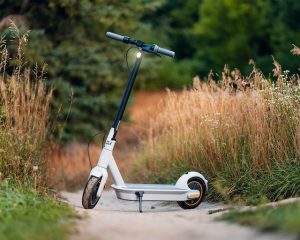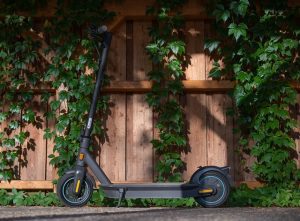We’ve all enjoyed the thrill of cruising around on a scooter, feeling the wind in our hair and the exhilaration of speed. But have you ever stopped to think about the lifespan of your trusty two-wheeler? Understanding the lifespan of scooters is not just about ensuring the fun lasts; it’s also about safety.

Let’s face it, we all want to make the most out of our electric scooters while keeping everyone safe. With our years of personal experience and practical advice, we hope to assist you in achieving just that.
So, strap on your helmet, and let’s dive into the world of electric scooters together. From the top brands like Razor, Xiaomi, and Segway to the various new models such as frame, kick, and folding vehicles, we’ll explore the options and help you make the best decision for you.
We’d love to hear your feedback on the content, your experience, or your opinions. Share your thoughts and join the conversation at FamilyHype!
Key Takeaways
- Regular maintenance and care, including regular cleaning and checking tire pressure, can extend the lifespan of a scooter.
- Proper storage methods, such as avoiding damp and humid conditions, can help prevent premature wear and tear.
- Customization and replacing worn-out parts can improve the durability of a scooter and prolong its lifespan.
- Signs of a worn-out scooter include mechanical failures, dwindling battery performance, and physical damages, indicating it may be time to consider buying a new scooter.
Overview Of A Scooter’s Lifespan
While it’s hard to pinpoint an exact lifespan for every scooter, you’ll typically find that good maintenance and responsible use can greatly extend the fun and safety it offers over time.

Just think back to our first scooter rides, and how we’ve watched scooter evolution making these rides smoother and safer. With the right riding techniques, we’ve seen our kids’ scooters last for years, becoming cherished childhood companions.
Yet, as we all know, not every scooter tells the same story. It’s our responsibility to ensure that these fun machines serve us well, keeping us safe while giving us joy.
But what exactly determines how long a scooter will last? Let’s explore that as we delve into the factors affecting the scooter’s lifespan.
Factors Affecting Scooters Lifespan
We’ve all had that favorite electric scooter that’s seen better days, right? It’s important to remember that the longevity of our trusty e-scooters doesn’t just hinge on how often we use them, but also on the quality of the materials they’re made of and how well we care for them.
In the early days of shared electric micromobility, these vehicles were put through rigorous use, often leading to premature wear and tear. However, as technology and materials have improved, the vehicle lifespan has increased significantly.
From our experience, regular maintenance and a little TLC can make a world of difference in extending the lifespan of your electric scooter, no matter how often it hits the pavement. So, whether you own a personal e-scooter or use shared electric micro-mobility services, taking good care of these eco-friendly rides ensures they stay in excellent shape for longer.
Quality Of Materials And Electric Scooter Parts
You’ll surely appreciate the good care we take in ensuring the long-lasting performance of your electric scooter, made possible by the high-quality electric scooter parts and materials we use in the construction process. We prioritize material selection, including electric scooter batteries such as lead-acid batteries, nickel-metal hybrid batteries, and lithium-ion batteries, to ensure that your battery lasts. We follow a standard methodology for thorough durability assessments to guarantee that every ride you take is not only enjoyable but also safe.
It reminds us of the time when we once used subpar materials in our initial models. We quickly learned our lesson when customers reported rapid wear and tear. We took this to heart, and since then, we’ve upped our game, using only the best materials, including electric scooter batteries like nickel-metal hybrid batteries and lithium-ion batteries, that can withstand heavy use and resist the elements. Our commitment to quality ensures that your scooter frame is barely more sustainable than ever before.
However, remember that even the best materials and electric scooter parts can only go so far. Another significant factor to consider is how often you use your electric scooter and how long electric scooters last, which we’ll explore next.
Frequency Of Use And Electric Scooters Lifespan
Don’t forget, how frequently you ride your e-scooter also plays a massive role in its lifespan. If you’re using most electric scooters every day for commuting, it’s going to wear out faster than if you’re only using them for leisurely weekend rides. The riding frequency, combined with the user’s weight, can significantly affect the scooter lifespan of your electric scooter.

It’s similar to our bodies, right? If we overwork without proper rest and care, we wear out faster. We’re not saying you shouldn’t enjoy your e-scooter, quite the contrary! We want you to make the most out of it. But remember, everything is in moderation. Balance your riding frequency with regular maintenance to prolong the lifespan of an electric scooter.
Maintenance For Electric Scooters
So, you’re keen on keeping your electric scooter in top-notch condition, right? Let’s crack on with some essential maintenance tips and care practices that’ll help your e-scooter stay in its prime for longer.
- Scooter customization isn’t just fun but can also extend your E-scooter’s lifespan. Think of it as serving your scooter as it serves you.
- Replace worn-out electric scooter parts, such as E-scooter batteries, with high-quality ones. It’s an act of kindness towards your electric scooter, and it’ll thank you for performing better and lasting longer.
- Add personal touches like custom grips or decals. It’s a great way to express your personality, plus it makes maintaining your e-scooter more enjoyable.
- Proper storage methods are crucial. Sheltering your electric scooter from harsh weather conditions can prevent premature wear and tear.
- Use a scooter cover or store it indoors when not in use. It’s like giving your electric scooter a cozy home.
As we move on, let’s delve deeper into some regular maintenance tips to keep your electric scooter running smoothly.
Tips For Scooters Lifespan
Regularly checking your electric scooter’s tire pressure and electrical components isn’t just about smooth rides, it’s also a vital step in preventing accidents and prolonging its lifespan.

We’ve found that maintaining proper tire inflation, as well as ensuring the health of the electrical components, can greatly affect the overall performance and safety of your e-scooter. Just like we make sure our car tires are properly inflated, the same consideration should be given to our electric scooters.
Equally important are the storage conditions for your electric scooter. We’ve noticed that e-scooters stored in damp, humid conditions tend to break down faster. Keep it in a dry, cool place to help preserve its parts and function.
Now, let’s move on to learning how to spot signs of a worn-out scooter’s life.
Signs Of A Worn-Out Scooter
We’ve all been there—your favorite scooter starts acting up and you’re left wondering whether it’s just a hiccup or a sign of something more serious.
From mechanical failures like unresponsive brakes or a shaky ride to dwindling battery performance, and even visible physical damages, these are all tell-tale signs your trusty scooter might be on its last legs.
Don’t worry though, we’re here to help you understand these signs better and guide you on what to do next.
Mechanical Failures
Don’t overlook the importance of checking your scooter for mechanical failures; it’s a key step to ensure both your safety and the longevity of your ride. We’ve seen riders ignore minor issues that later turn into major problems. Remember, even the highest quality scooters can sometimes have manufacturing defects.
Keep an eye out for wear and tear that’s out of the ordinary, especially if the rider’s weight is on the heavier side. We’ve found that excessive weight can speed up the wear and tear process, leading to earlier mechanical failures.
Now, let’s shift gears and discuss something equally important. Battery performance is often overlooked but plays a crucial role in maintaining a scooter’s lifespan. So, up next, we dive into understanding battery health and how to maximize it.
Battery Performance
Believe it or not, your scooter’s battery health is a big deal and can either make or break your ride. It’s not just about keeping it charged; it’s about adopting the right charging practices. We’ve seen batteries deteriorate rapidly due to poor charging habits, like overcharging or using the wrong charger. A simple change, like unplugging once fully charged, can extend your scooter’s battery life significantly.
Exploring battery alternatives is another great move. We’ve personally tested lithium-ion batteries and found them to be longer-lasting and more efficient. Of course, it’s not always about the fancy upgrades; sometimes, it’s just about good old-fashioned care and maintenance.
Now, let’s get into another crucial aspect that can impact your scooter’s longevity – dealing with physical damage.
Physical Damages
Now, as we transition from the vitality of battery performance, let’s steer the discussion toward an equally important aspect: Physical Damages. It’s inevitable; our scooters suffer from bumps and bruises over time. But, how we handle these can determine their longevity and our safety.
To minimize the Damage Impact, regularly inspect for any visible damages or wear and tear. Ensure the scooter is stored in a safe, dry place to prevent rusting. Avoid overloading the scooter beyond its capacity. Use the scooter on suitable terrains. Invest in quality protective gear.
These Damage Prevention measures can significantly reduce the potential for serious harm. Now, with a firm grasp on the issues of battery performance and physical damages, let’s smoothly glide into the measures we can take to truly extend our scooter’s lifespan.
Steps To Prolong Your Scooter’s Lifespan
To maximize your scooter’s longevity, you must learn and implement a few key maintenance strategies. We’ve found that a little TLC can go a long way in extending the life of your scooter.
Regular cleaning is a must, as debris can cause wear and tear over time. Don’t be afraid to get creative with scooter customization, either. Sometimes, innovative enhancements can improve the durability of your ride. For instance, we once added a protective layer to our scooter to shield it from harsh weather conditions, which significantly prolonged its lifespan.
In the end, it’s all about understanding your scooter and taking proactive measures to ensure its longevity.
When To Consider A Replacement
Despite your best efforts, there comes a day when your trusty ride starts showing signs of fatigue and that’s when you should start thinking about finding a worthy successor. We’ve all been there – the squeaky wheels, the sluggish start, the worn-out handle grips. Ah, the memories! But let’s face it, it’s time to consider an upgrade.
Look out for these signs:
- Frequent breakdowns despite regular maintenance
- Difficulty in finding replacement parts
Ponder on these factors:
- Scooter customization: A new scooter gives you the freedom to customize it to your heart’s content.
- Upgrade options: Modern scooters come with nifty tech upgrades like GPS, electric start, and more.
Remember, change can be good! Next, let’s talk about bidding a respectful goodbye to your old friend.
Dispose Of An Old Scooter Responsibly
Parting with your old scooter can be difficult, but it’s important to do so responsibly, not just for the environment, but also for your peace of mind.
We’ve all been there, saying goodbye to a beloved possession, but think of this as an opportunity to serve others. Consider recycling options for your old scooter. Many cities have facilities where you can drop them off. This way, your scooter’s parts can be used again, reducing waste.
Alternatively, explore upcycling ideas. With a little creativity, your scooter can take on a new life as a piece of home decor or a unique plaything. It’s a win-win!
Buying A New Scooter
Now that you’ve responsibly taken care of your old ride, let’s dive into the thrilling world of selecting your brand-new scooter! We understand that the decision can be overwhelming, but don’t worry, we’re here to help.
Consider these key factors:
- Scooter Customization: Want a scooter that reflects your personality? Look for models that offer customization options. From vibrant colors to personalized decals, let your scooter be an extension of you!
- Cost Considerations: While the allure of a high-end model might be tempting, it’s essential to choose a scooter that fits your budget.
Remember, a scooter is more than just a ride; it’s an opportunity to serve the community by reducing carbon emissions.
Safety Tips For Riding A Scooter
Keeping your well-being at the forefront of your mind, let’s delve into essential tips for secure scooter riding, as mastering these will surely elevate your overall experience.
We can’t stress enough the importance of helmet usage. It’s not just about complying with regulations – it’s about protecting your precious brain. We’ve seen too many avoidable injuries that could’ve been prevented with a helmet.
Don’t underestimate the power of visibility gear either. We’ve found that bright clothing and reflective accessories significantly reduce the risk of accidents, especially when riding in low-light conditions. It’s a simple way to ensure drivers can see you.
Balancing Fun And Safety
So, you’ve got your helmet snugly fastened and your high-visibility gear on – you’re all set to embrace the thrill of the ride without compromising your safety. We can’t stress enough the importance of safety gear. It’s not just about protecting you; it’s about ensuring you can continue to serve and bring joy to others.
Balancing safety with fun means learning to do fun riding tricks safely, like taking corners smoothly or learning how to handle different terrains. We remember when we first mastered these tricks, the exhilaration was unmatched! But remember, always practice new tricks in a safe place before taking them to the streets.
Conclusion
We’ve been there, loving the thrill of riding a scooter and the freedom it brings. But remember, safety and upkeep go hand-in-hand with the fun. Let’s ensure our scooters are in top shape, replace them when they’ve run their course, and always ride responsibly.
It’s not just about prolonging the joy of scootering, it’s about keeping each other safe on the streets. After all, the best rides are the safe ones.
At FamilyHype, we understand the importance of scooter safety and longevity, as well as the fun that comes with them. We would love to hear your feedback on scooter rides, maintenance, and other related topics. Let’s discuss the best practices for scooter care, from tire pressure and battery life to smart safety features and more.
With the right care and maintenance, your scooter can be a source of joy for years to come.
Frequently Asked Questions (FAQs):
What Is The Lifespan Of A Shared Scooter?
The average lifespan of a shared scooter depends on various factors such as the quality of the scooter, weight limit, average lifespan of electric scooters, and proper maintenance. Electric scooters, including shared ones, typically have a lifespan of around 2 to 3 years with regular use.
What Is The Lifespan Of A Lime Scooter?
Lime scooters are electric scooters that are commonly used for shared mobility. Their lifespan is influenced by factors such as battery capacity, riding habits, and the scooter’s motors. With proper maintenance and care, Lime scooters can last between 2 to 3 years.
How Can I Make My Scooter Last Longer?
To extend the lifespan of your scooter, it’s important to follow a few guidelines. Firstly, choose a quality scooter with a sturdy build. Regularly maintain and service your scooter, including checking the battery and tires. Adhere to weight limits and avoid overloading the scooter. Additionally, practice safe riding habits and avoid rough terrains or excessive speeds that may strain the scooter’s components.
What Are The Disadvantages Of A Scooter?
While scooters offer convenient and eco-friendly transportation, they do have some disadvantages. Firstly, electric scooters require proper maintenance to ensure optimal performance and lifespan. They have a limited range compared to other vehicles, making them less suitable for long drives. Scooters are also affected by weather conditions, and riding in rain or snow can be challenging. Additionally, scooters are more vulnerable to theft due to their portability.
Does The Scooter Battery Last?
Yes, scooter batteries do have a limited lifespan. Most electric scooters use lithium batteries, which have a finite number of charge cycles. With proper care and charging habits, the battery of a scooter can last several years. However, over time, the battery capacity may decrease, resulting in reduced range and performance. Regularly checking and maintaining the battery can help prolong its lifespan.
What Causes A Scooter To Go Slow?
Several factors can cause a scooter to go slow. One common reason is a low battery or a battery nearing the end of its capacity. Other potential causes include motor issues, such as a malfunctioning controller or worn-out components. Tire pressure, weight overload, or riding uphill can also affect the scooter’s speed. Proper maintenance, including regular inspections and addressing any mechanical problems, can help resolve speed-related issues.
Is A Scooter Good For Long Drives?
Scooters are generally designed for short to medium-range commutes rather than long drives. Their compact size, limited battery capacity, and lower speed compared to motorcycles or cars make them less suitable for long-distance travel. While some scooters have longer battery ranges, it’s essential to consider your specific needs and plan accordingly. For extended journeys, alternative modes of transportation might be more practical.
Why Is My Scooter Losing Speed?
A scooter’s losing speed can be attributed to various factors. Some possible causes include a low battery charge, worn-out motor components, improper tire pressure, or excessive weight on the scooter. Another reason could be a malfunctioning controller, which regulates the scooter’s speed. Regular maintenance, including checking the battery, motor, and tires, can help diagnose and address speed-related issues.
Which Is Safer, A Scooter Or A Bike?
When it comes to safety, both scooters and bikes have their advantages and considerations. Scooters often have a lower maximum speed compared to bicycles, which can contribute to a perception of increased safety. However, scooters offer less protection in case of a collision and may lack safety features such as airbags. Bicycles, on the other hand, provide better maneuverability and are more visible on the road. Ultimately, the safety of either vehicle depends on factors like rider behavior, adherence to traffic rules, and the surrounding environment.
Is A Scooter Safer Than A Motorcycle?
In general, scooters are considered safer than motorcycles due to their lower speed capabilities and typically smaller engine sizes. Scooters also have a lower center of gravity, which can contribute to better stability and handling. However, it’s important to note that safety ultimately depends on factors such as rider experience, adherence to safety precautions, and the usage of proper protective gear. Both scooters and motorcycles have their inherent risks, and responsible riding practices are crucial for minimizing accidents and injuries.
